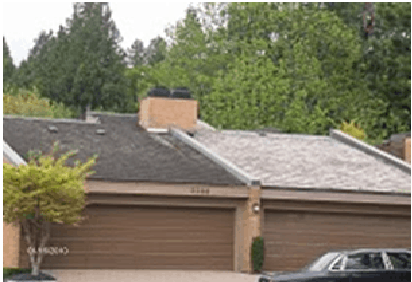Are you a fan of the “classic” or “rustic” look of cedar as a roof or siding treatment? Seal-It would like to pass on information that we feel is important to you. “Bad news – good news” scenario; bad news, cedar is not what it once was; good news, Seal-It can help.
“Cedar Shake Roofs do not last as long as they used to”1
The younger or second growth raw cedar blocks that are normally used for producing new Cedar Shakes produce two specific problems. First, it is harder to produce good hand-split cedar shakes from wood with the wider grain of young cedar blocks. Good Hand-Split shakes have had the longest life expectancy, but without sufficient supply, the product of choice is now being produced is the “Tapersawn Shake”. A fully sawn 5/8″ thick shake, it takes the lowest pick of the raw wood pile to produce this machine made shake, and it is now the “normal” shake provided by the industry in South West B.C.
Tapersawn shakes have shown to have a shorter life expectancy as a roofing material. Where some may survive to 14 or 18 years of age before requiring re-roofing, many roofs with Tapersawns have suffered premature failure in as little as 8 to 10 years. This is a very short useful life for a roof as expensive as a cedar shake roof.
The second problem, related to the newer growth cedar being produced into shakes and Tapersawn shakes, is the lateral strength of the wood as well as the rot resistance of the wood is diminished. Younger Cedar does not contain as much natural oils and density of wood as the old growth product. Tapersawn shakes can often be seen curling up, cracking diagonally and checking, as well as weeping water through the cedar itself.”
“Cedar Roofs: The Pros and Cons2
- Quality matters on cedar shingles. The heartwood of old growth western red cedar is rated as extremely durable because of its extractives. There is consensus that second growth timber is not as durable as the old-growth timber.
- Wood Shingles absorb moisture because their lower edge is exposed end grain. This end grain works like a straw to wick in moisture. The moisture results in swelling and shrinking of the wood that can eventually result in cracks. Decay occurs when untreated wood remains wet for long periods.”
Many articles can be found that discuss how cedar and other wood species do not have the same properties they once had. These lost properties were high on the list that made these species desirable. Predominately cedar is purchased for “outdoor” projects, and to require minimal care for many years. There seems to be evidence that this is not what we are getting anymore.
You can still use cedar for its “rustic” and “classic” look. By adding Seal-It Wood Sealant, you can have the longevity of your roofing, siding and outdoor structures. Just ask Mr. Gary Puckey. Gary has been in the roofing trade for over 38 years in south western British Columbia, Canada. He has seen the change in the performance of cedar as a roofing material. He has seen the premature failure.
Mr. Puckey has also given new growth cedar the longevity of old growth cedar with the use of Seal-It Maintenance Cleaner and Seal-It Wood Sealant.
 “I’ve seen 40 year (old cedar roofing) that is still in good shape; I’ve seen “second growth” (cedar) that needs to be torn off and replaced at anywhere from 12 to 15 years; depending on the pitch.” says Gary. Gary recommends treating “second growth’ cedar with Seal-It before it’s too late. “Anything over 12 years should be torn off”, “up to 10 year old (cedar) can be cleaned with Maintenance Cleaner and treated with Wood Sealant and the roof will last another 25 years.” Mr. Puckey, the owner of www.clearlythebest.ca, says “I can save (a home owner) about $8000.00.” “A 20 square roof will cost about $12,000.00 to replace, whereas I can replace ridge cap, clean and seal (existing second growth cedar) for about $4000.00.”
“I’ve seen 40 year (old cedar roofing) that is still in good shape; I’ve seen “second growth” (cedar) that needs to be torn off and replaced at anywhere from 12 to 15 years; depending on the pitch.” says Gary. Gary recommends treating “second growth’ cedar with Seal-It before it’s too late. “Anything over 12 years should be torn off”, “up to 10 year old (cedar) can be cleaned with Maintenance Cleaner and treated with Wood Sealant and the roof will last another 25 years.” Mr. Puckey, the owner of www.clearlythebest.ca, says “I can save (a home owner) about $8000.00.” “A 20 square roof will cost about $12,000.00 to replace, whereas I can replace ridge cap, clean and seal (existing second growth cedar) for about $4000.00.”
1 roofingstore.ca
2 helpinaflash.com
